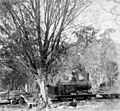Wielangta forest facts for kids
The Wielangta forest is a special place in south-east Tasmania, Australia. It's known for its beautiful trees and important wildlife. This forest was part of a big discussion in 2006 about how Australia manages its forests. People wanted to make sure these important places are looked after properly, especially for the rare animals and plants that live there.
Contents
What's in a Name?
The name Wielangta comes from an Aboriginal word. It means "high trees," which is perfect for this tall forest!
A Home for Rare Animals and Plants
The Wielangta forest is a very old forest. It has survived since the last ice age, making it a unique "refugia" area. It has tall blue gum eucalyptus trees and cool, damp rainforest areas.
This forest is a key home for many rare and threatened animals. These include the Tasmanian wedge-tailed eagle, which is a very large bird of prey. The colourful swift parrot also lives here. You might also find the Wielangta stag beetle, the spotted-tail quoll (a native cat-like animal), and the eastern barred bandicoot. A rare type of orchid, called Genoplesium nudum, has also been found growing in the forest.
The Wielangta forest is part of a larger area known as the South-east Tasmania Important Bird Area. This means that BirdLife International has identified it as a very important place for protecting many kinds of woodland birds.
The Old Wielangta Tram
Long ago, there was a special forest railway called the Wielangta tram. It was more than 6.5 kilometres (about 4 miles) long. This railway ran on steel and wooden tracks. It started in the Wielangta forest, following the Sandspit River.
The tram carried cut timber from the forest to sawmills in the Wielangta settlement. From there, the wood went to the east coast, right across from Maria Island. The sawn timber was loaded onto ships from a pier on Rheban beach, south of Orford. The tram had a steam engine built in Hobart.
Life in the Wielangta Settlement
In its busiest time, the Wielangta settlement was a small town. It had several sawmills, a general store, a bakery, a blacksmith, and even a school. About one hundred pioneers lived and worked there. They worked from 1911 to 1924.
The sawmill closed because there wasn't enough wood left to cut. The workers then moved away. Sadly, bushfires damaged the settlement in the 1920s. By 1928, the settlement was completely empty.








